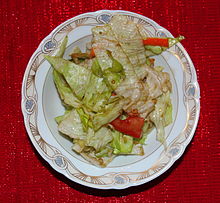Iceberg lettuce
As iceberg lettuce , including iceberg lettuce , several are varieties of garden lettuce ( Lactuca sativa var. Capitata nidus tenerimma ) labeled tightly closed heads ( lettuce ). They belong together with the Batavia , an older form with an upwardly open minds, to Crisphead- group . The stem axis is strongly compressed, the leaves overlap and form a dense, rounded "head". The inner leaves of iceberg lettuce are consumed.
description
The general properties of the iceberg lettuce are similar to those of the other garden salads : they are one to two-year-old plants with a long taproot that initially form a basal leaf rosette , later the branched inflorescence appears with numerous yellow flowers .
In the iceberg lettuce group of varieties, the stem axis is strongly compressed, so that the leaves surrounding the stalk sit close together, overlap and form a closed head. The shape is regularly round, the outer leaves are curved outward and dark green. The inner leaves are tightly enclosed by the outer leaves and can no longer unfold. They stay light green, firm, crisp and are wrinkled into one another. As the inner leaves grow, the head of lettuce can burst.
history
The older form with the heads open at the top, the batavia lettuce , comes from France, the first closed iceberg heads were bred in North America. At the beginning of the 20th century, lettuce production began to concentrate in the USA. It was grown extensively in the west of the country and shipped from there. Batavia lettuce was best suited for this: By 1923, the Batavia variety New York was the market leader. The first closed iceberg variety was Great Lakes . In this context, the legend about the origin of the name arose: Because there were no refrigerated wagons back then, the lettuce was transported by train from the west to the east on large blocks of ice, including icebergs, so that it was still fresh on the east coast even after thousands of kilometers to arrive. However, this name explanation seems to be a myth.
The salad is also called crisphead in English .
use
Iceberg lettuce is mostly eaten raw as a salad , less often than cooked vegetables.
At a temperature of 0 ° C and a relative humidity of 95 to 98%, the storage time is two to three weeks.
100 g iceberg lettuce has a calorific value of 60.7 kJ (14.5 kcal ) and contains:
| component | amount |
|---|---|
| water | 95% |
| Proteins | 1.05 g |
| carbohydrates | 2.4 g |
| Fats | 0.16 g |
| Fiber | 0.51 g |
| sodium | 7 mg |
| magnesium | 11 mg |
| phosphorus | 26 mg |
| potassium | 166 mg |
| calcium | 22 mg |
| iron | 1.5 mg |
| Vitamin A | 470 IU |
| vitamin C | 7 mg |
| Vitamin B1 | 0.06 mg |
| Vitamin B2 | 0.07 mg |
| niacin | 0.3 mg |
literature
- Vincent E. Rubatzky, Mas Yamaguchi: World Vegetables: principles, production and nutritive values . 2nd Edition. Aspen Publishers, Gaithersburg 1999, ISBN 0-8342-1687-6 , pp. 334-347 (English).
- Edward J. Ryder: The New Salad Crop Revolution . In: J. Janick, A. Whipkey (Ed.): Trends in new crops and new uses . ASHS Press, 2002, pp. 408-412 (English, purdue.edu ).
Movie
- 60 million iceberg salads. Documentary, Germany, 2017, 28:30 min., Script and director: Jessica Becker, production: Cassandra Media, NDR , series: Wie geht das? , First broadcast: July 19, 2017 at NDR, table of contents by NDR, online video by NDR.
Web links
Individual evidence
- ↑ P. Hanelt & IPK (Eds.): Mansfeld's Encyclopedia of Agricultural and Horticultural Crops ( online )
- ^ EJ Ryder (2002): The New Salad Crop Revolution . In: J. Janick, A. Whipkey (Ed.): Trends in new crops and new uses . ASHS Press. Pp. 408-412.
- ^ Helen Rosner: It's Time to Admit That Iceberg Is a Superior Lettuce. The New Yorker , August 8, 2018.
- ↑ Vincent E. Rubatzky, Mas Yamaguchi: World Vegetables: principles, production and nutritive values . 2nd Edition. Aspen Publishers, Gaithersburg 1999, p. 821 .
- ↑ Vincent E. Rubatzky, Mas Yamaguchi: World Vegetables: principles, production and nutritive values . 2nd Edition. Aspen Publishers, Gaithersburg 1999, p. 806 .



